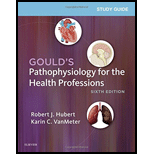
Concept explainers
To describe: Difference between dose and dosage.
Introduction: A drug is a substance that alters the biological activity in a person. A drug has more than one effect on the body; some of them are desirable and some are undesirable. Every drug has its optimum therapeutic concentration and frequency of administration.
Explanation of Solution
The frequency and dose of a drug is very important to maintain effective concentration in the body. A drug enters the body by a chosen route, circulates through the blood stream, and reaches the site of action. Once there, the drug shows its effects, is
The difference between the terms “dose” and “dosage” is given below:
Dosage refers to the total amount of the drug given over a period of time. Therefore, it includes the amount of drug and time duration.
Dose refers to the amount of a drug given at a single time. Therefore, many doses would be in a dosage.
Want to see more full solutions like this?
Chapter 3 Solutions
Study Guide for Gould's Pathophysiology for the Health Professions
- A 40-year-old male farmer was rushed to an ER with complaints of fever, abdominal pain/tenderness, nausea and vomiting. Clinical examination and investigations revealed diagnosis of typhoid perforation and he was booked for exploratory laparotomy. Explain in detail the pre - operative care of this patient.arrow_forwardAs a nursing student wanting to do preceptorship at ICU or ER, answer the following question: Why are you requesting this site? How will this unit meet your learning needs?How will this unit contribute to your professional goals?arrow_forwardAs a nursing student wanting to do preceptorship at the cancer clinic. Answer the following question. Why are you requesting this unit? How will this site meet your learning needs? How will this unit contribute to your professional goals?arrow_forward
- The importance of monitoring resident's wound healing (bed sores, cuts, and scrapes, etc.) and how can a nutritionist utilize this in their career? Please not just a short explanation.arrow_forwardThe importance of seeing how it is to work as a chief in a nursing home and how they accommodate for special diets (low sodium, low sugar, heart healthy, etc.) and how can a nutritionist utilize this in their career? Please not just a short explanation.arrow_forwardThe importance of dealing with work confrontation (different healthcare departments fighting; diet aide and CNA) as a manager of a kitchen and how can a nutritionist utilize this in their career? Please not just a short explanation.arrow_forward
 Phlebotomy EssentialsNursingISBN:9781451194524Author:Ruth McCall, Cathee M. Tankersley MT(ASCP)Publisher:JONES+BARTLETT PUBLISHERS, INC.
Phlebotomy EssentialsNursingISBN:9781451194524Author:Ruth McCall, Cathee M. Tankersley MT(ASCP)Publisher:JONES+BARTLETT PUBLISHERS, INC. Gould's Pathophysiology for the Health Profession...NursingISBN:9780323414425Author:Robert J Hubert BSPublisher:Saunders
Gould's Pathophysiology for the Health Profession...NursingISBN:9780323414425Author:Robert J Hubert BSPublisher:Saunders Fundamentals Of NursingNursingISBN:9781496362179Author:Taylor, Carol (carol R.), LYNN, Pamela (pamela Barbara), Bartlett, Jennifer L.Publisher:Wolters Kluwer,
Fundamentals Of NursingNursingISBN:9781496362179Author:Taylor, Carol (carol R.), LYNN, Pamela (pamela Barbara), Bartlett, Jennifer L.Publisher:Wolters Kluwer, Fundamentals of Nursing, 9eNursingISBN:9780323327404Author:Patricia A. Potter RN MSN PhD FAAN, Anne Griffin Perry RN EdD FAAN, Patricia Stockert RN BSN MS PhD, Amy Hall RN BSN MS PhD CNEPublisher:Elsevier Science
Fundamentals of Nursing, 9eNursingISBN:9780323327404Author:Patricia A. Potter RN MSN PhD FAAN, Anne Griffin Perry RN EdD FAAN, Patricia Stockert RN BSN MS PhD, Amy Hall RN BSN MS PhD CNEPublisher:Elsevier Science Study Guide for Gould's Pathophysiology for the H...NursingISBN:9780323414142Author:Hubert BS, Robert J; VanMeter PhD, Karin C.Publisher:Saunders
Study Guide for Gould's Pathophysiology for the H...NursingISBN:9780323414142Author:Hubert BS, Robert J; VanMeter PhD, Karin C.Publisher:Saunders Issues and Ethics in the Helping Professions (Min...NursingISBN:9781337406291Author:Gerald Corey, Marianne Schneider Corey, Cindy CoreyPublisher:Cengage Learning
Issues and Ethics in the Helping Professions (Min...NursingISBN:9781337406291Author:Gerald Corey, Marianne Schneider Corey, Cindy CoreyPublisher:Cengage Learning





